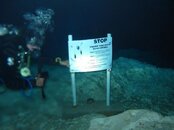what the Brazilians thought is pure speculation, we will never know what they thought and what they were told
the point is no matter who you think you diving with why would you go beyond the
skull-and-crossbones sign, its universally known what it means
Everything in this thread is speculation and assumptions. It is really all we have to go on. You even speculate below. However, I think it is a safe assumption that the divers trusted their guide to some level. Once you are in some of these cenotes and you have lights going, it can be hard to distinguish the cavern from the cave. Skull & Crossbones signs are ignored all the time. Many people have the "That does not apply to me, I am with a trained guide" attitude.
please correct me if i'm wrong
-you need more than OW certification to go diving where there's an overhead environment
-my understanding is that when you go diving in a cenote you will have a view of the sky, no overhead environment
Well, you should IMO. However, on cenote dives, typical rules do not count. You will have no view of the sky, you might not even have an open area above you, it will be just rock. You should however be able to see visible light from the entrance at all times.
now if that is true why where they so far inside the cavern?
other question is why did they accept to go so late in the day?
The tour is inside the cavern. They were inside the cave. I can not answer your questions though. No one will ever know.
it is very unfortunate that our society has taught us to be ignorant and complacent and blindly trust someone else with our own life because we can turn around and sue them if something goes wrong
the internet has everything imaginable and those that wish to be informed will have no trouble educating themselves
agreed
what i am getting at is that there was a point in that dive when the two Brazilians should have recognized that they are headed to an area that is off limits and had a choice to call the dive
of course this is still all speculation and we will never know the truth unfortunately

i strongly believe that everyone should continue to exercise their own judgement no matter how qualified you think the guide is, after all is your own life on the line
You are right. That point might not have been until they actually turned around. We do not know what was briefed or planned for this dive.
please understand that i am in no way trying to be a smart a**, just want to educate myself and express my own opinions in the process
Whatever smart ass. 





